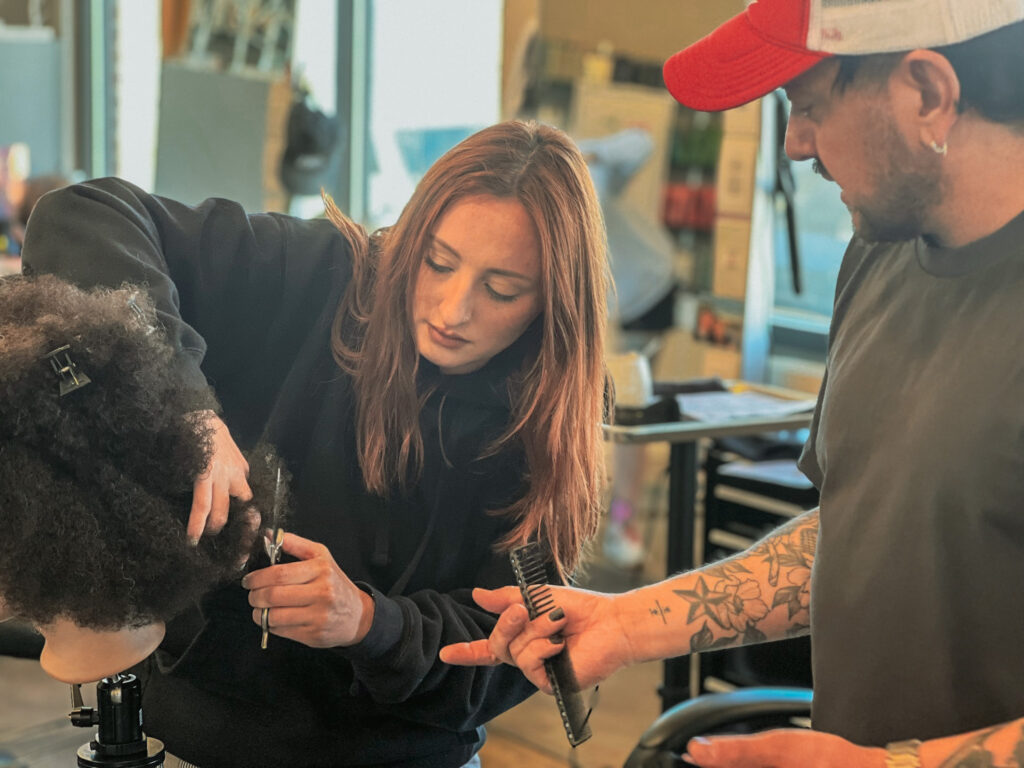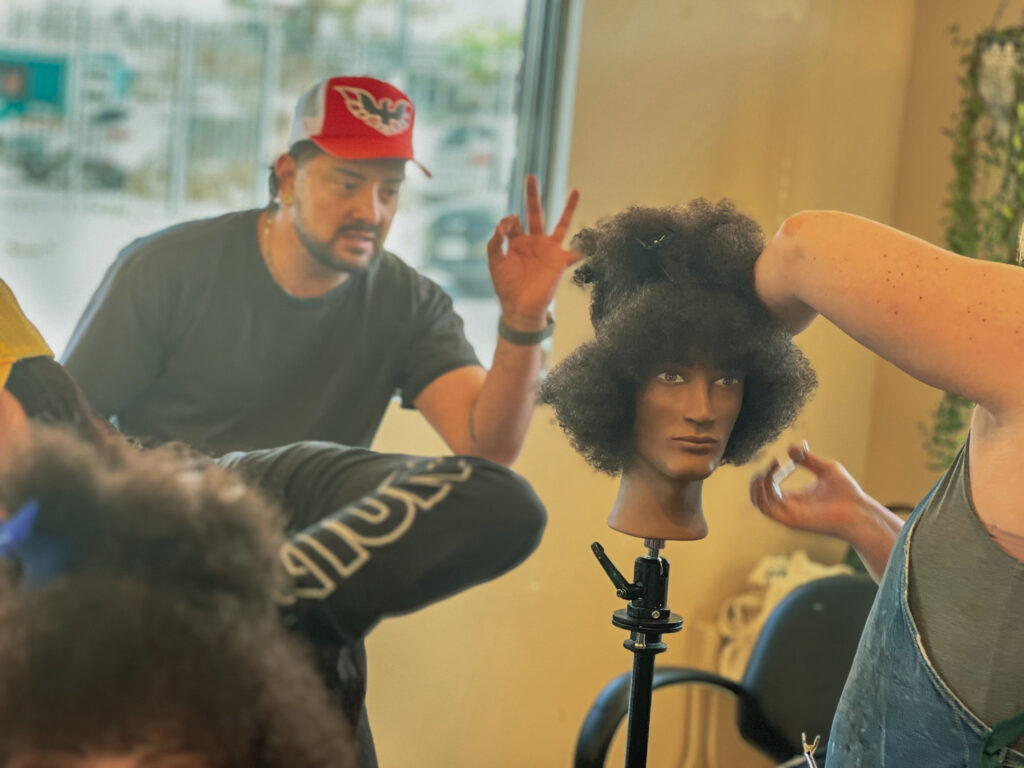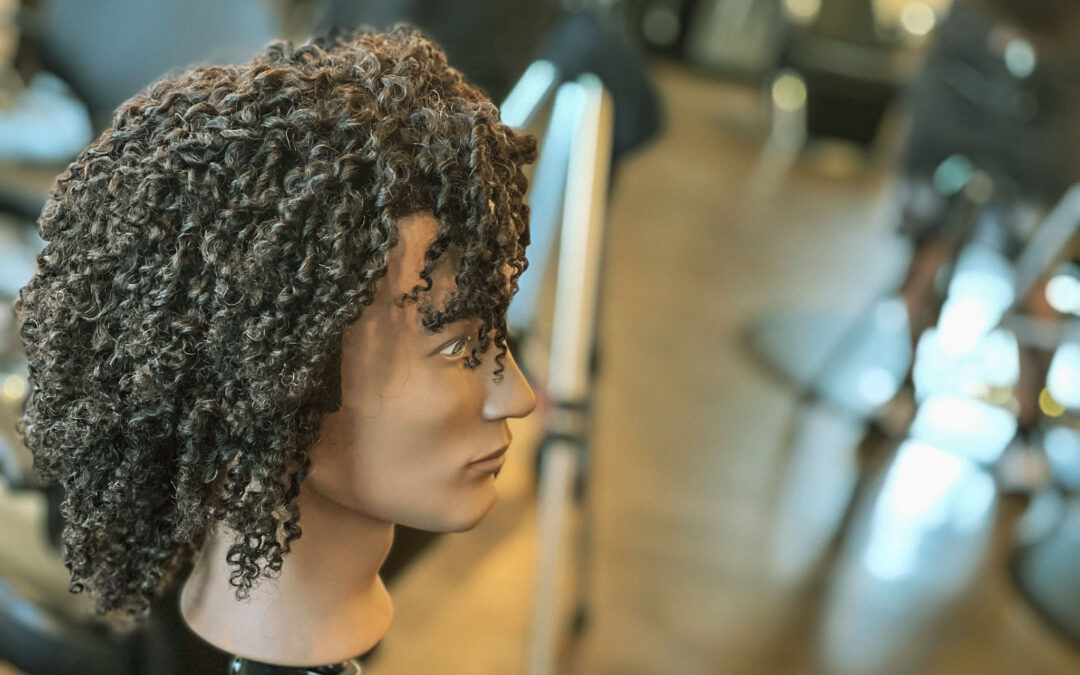Whether you have curly hair or you’re a hair professional, hearing the words “curly haircut” most likely sends chills down your spine. Curly-headed folk are unlikely to trust anyone with straight hair and shears, and the education most cosmetology students gain severely lacks in curly cutting, leaving many of them just as anxious. So, what’s the solution? Starling Salon.

A few times a year, Starling brings in the best educators the hair industry has to offer, and the first class this year kicked off with Ron Lopez, a L’Oreal professional. With almost three decades of salon experience, national competition wins, and countless photoshoots under his belt, this is where the best curly cutters go to learn how to master your coils. Starling Salon isn’t the only space in Denver dedicating their education to curly hair, but they’re in the minority. They’re sick of the timeless narrative accusing most hair stylists of lacking the knowledge to cut curly hair, so they’re learning.
While they’re at it, there’s plenty for you and your curly friends to learn. Styling curly and coily hair isn’t a piece of cake just because you have curly or coily hair, so it’s okay if you need help. Understanding shapes and techniques isn’t your responsibility because that’s how your hair grows. Take a deep breath and let your knowledgeable stylist direct you.

Before The Appointment
There’s good news and bad news. The bad news, your haircut will take longer because you have curls/coils. The good news, you won’t need haircuts as often. The way artists schedule and charge for curly services is not meant to penalize anyone, but accommodate all parties, and they keep timing in mind. Understanding that your hair needs more attention is crucial to your appointment. Arriving unprepared could mean rescheduling. It’s okay to ask how long your appointment will be while booking, but don’t forget that’s an estimate. Every service is as unique as a snowflake; comprised of the same things but never repeated exactly.

Part of the essential prep for your haircut is how you wash and style. Shampoo, condition, air dry, and style as close to your service as possible. This allows your stylist to see how your hair lives from day-to-day. It shows them where that one strand of loose curls hides, if one section is heavier than others, or any other things best viewed in person.
Like any appointment, the consultation is invaluable. It’s the best time to express your goals, share inspo photos, and even vocalize your fears. Your artist might be fabulous, but they still can’t read your mind. If your biggest fear is losing several inches, tell them. They know curly hair takes longer to show growth, meaning big chops are harder to come back from. Now, you’re both on the same page. While they’re assessing your wants, they’re feeling your head shape and testing your density, elasticity, porosity, and other factors.
Most curly hair doesn’t hide its dehydration, but Starling pros still check. The more porous the hair, the more moisture products you’ll pile on come styling time. If your hair lacks elasticity, you might experience shrinkage differently, and if you have a higher density, you might want more softness. It’s not your job to know this terminology, but understanding these traits about your hair is always beneficial.

Appointment Time
The appointment is your chance to roll those shoulders back, close your eyes, and enjoy a pampering experience. Curly and coily guests might have a harder time with that, but Starling artists are mastering your hair so you can sink into the relaxation like every other guest.
It’s okay to be curious about what they’re doing; educated parties communicate better. So, how are they cutting your hair?
On all hair types, cutting a blunt (straight across) line creates weight and heaviness. Creating that weight around the hairline helps establish where your hair will live, but the interior shape will likely look different. Taking zigzag sections with their fingers, your stylist will carve out space for softness and to form your desired shape. What’s the takeaway? If the shears are cutting straight across the ends of your hair, you’ll see more weight remaining and more length removed. If the shears are curving through and taking out slivers of hair, you’re left with more volume. Ask your Starling expert about how this translates into your final cut.

Wide-toothed combs come in handy once you hit the shampoo bowl and there’s one word to focus on: detangle. A great comb and moisturizing product will make the job effortless. Remember, a lot of curls and coils live their days thirsty, so moisturizing should be a daily process. Co-washes are designed for curls, but other shampoos and conditioners packed with moisture infuse bounce back to your hair. For extra impact, keep a processing cap or shower cap over the hair waiting for product while you coat other sections. This keeps the water already clinging to your hair in place and primed for the rest of the products.
Post-Appointment
When your professional whips off the cape to reveal your cut, give them honest feedback. It’s your chance to share your constructive thoughts so they sculpt the perfect shape for you each time. Ask about what they used to style and how they applied it all (hint, plan on slathering that product). After a rich education from Ron Lopez, they’ve got plenty of tips to share with you.
Like keeping your styling products in the shower. When a knowledgeable hair professional tells you to apply curly hair products on wet hair, they mean dripping, sopping, soaking wet hair. No better time to apply product than the second you shut the water off, before anything has a chance to dry. The one product you don’t want to apply to wet hair is oil. Oil goes on dry hair because oil and water don’t mix. Basic science, right?

Ron recommends two products outside of the foams, creams, gels, and treatments. First, he encourages stylists to use a silicone brush to clear the scalp of excess skin around follicles during shampooing, so why not add the same brush to your in-shower products at home? The second item is a pineapple cap, which keeps fragile hair protected, like bonnets and other silk caps.
Starling understands the apprehension their curly and coily-haired guests feel when trying to book services from people who don’t have the same hair. Hopefully, this brief overview of their learning process lessens your anxiety on the topic. Mastering curly hair is important to them. Mannequins give them confidence, but your hair gives them the experience you want in your curly hair care provider.

If the lack of curly education in cosmetology schools frustrates you as much as it does Ron Lopez and Starling Salon, there’s something you can do about it. Find the organization The Texture of Change on Instagram (@thetextureofchange), a petition that Ron and his peers are bringing to light. Signing the petition will pressure schools across the country to build better lesson plans based on what Ron and others have developed. You can make sure every baby stylist leaves school with curly-cutting skills.
Visit the online booking page to schedule or call with questions.


Recent Comments